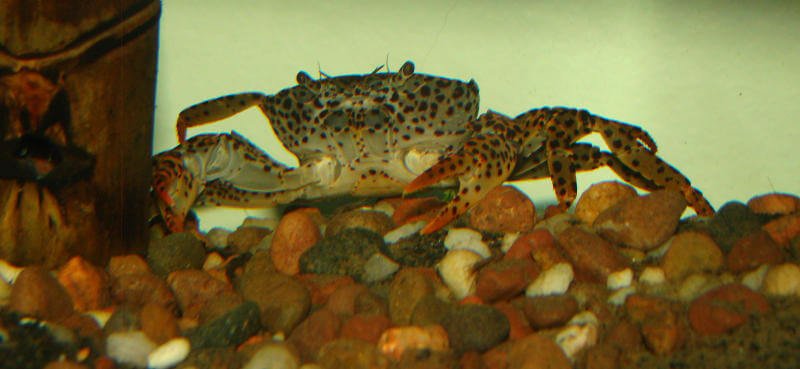The panther crab is a freshwater invertebrate that lives its entire life underwater. These crabs are often referred to as “leopard crabs” because of their distinct markings and coloration.
Although they live their entire lives submerged, these crustaceans do like having access to land and can be seen out of the water from time to time, even if it’s rare.
In this article
At a Glance
| Adult size: | 3-5” (7.5- 13 cm) |
| Minimum tank size: | 20 gal (75 l) |
| Temperature: | 76-82°F (24-28°C) |
| Diet: | omnivore |
| pH: | 7.5-8.5 |
| Behavior: | Territorial, semi-aggressive |
Origins

Panther crabs (Parathelphusa pantherina) originate from a single lake in Sulawesi, Indonesia called Lake Matano.
They are known to be fully aquatic, but some reports to have seen them on the shore as well.
Color and Appearance
Panther crabs are significantly larger than most other species of freshwater crab.
The carapace, or main body, reaches a size of 3 inches (7.5 cm) in adults! If you add in the length of the legs, this crab is capable of being a whopping 5 inches (13 cm).
For a saltwater crab, 5 inches is not a big deal, but for freshwater crabs? It’s huge!
Also referred to as the “leopard crab”, these crustaceans are orange and yellow with black, leopard-like spots.
These spots appear larger on the carapace and gradually decrease in size as they travel down the legs.
The orange color is strongest at the ends of the legs and claws.
Behavior and Tank mates
Much like their big cat namesake, panther crabs are territorial and aggressive.
They are opportunistic hunters and have no problem taking down a tank mate for a quick meal.
Shrimp, snails, and fish can all become prey to this particular crab, but if given enough hiding places, it may be possible to house them together with limited bloodshed.
Fish, more often than not, tend to be the first choice for a hungry crab, especially bottom-dwellers. So, sticking to an invert-only tank may be best.
It is possible to house multiple panther crabs together, but you will need a densely planted tank with ample hiding places. That way, the crabs will be able to establish their own territories.
Panther Crab Tank Setup
20 gallons (75 l) is the absolute minimum for this species. They prefer a slightly higher temperature and pH level than others.
An abundance of plant life and hardscape, driftwood and rocks, is a must.
Although fully aquatic, curious panther crabs love a good escape attempt and will try to break out from their enclosure if the opportunity presents itself. So always have a tight-fitting lid and cover any holes.
Panthers also might appreciate a small basking platform or maybe a piece of floating driftwood.
They live their entire lives underwater, but this species is known to appreciate a little access to land.
As for filtration and lighting goes, these crabs are not too picky. Like freshwater shrimp, they do appreciate oxygenated water, so sponge filters or any filter that creates some water agitation would be appreciated.
Feeding
Panther crabs are omnivores, but meaty foods make up a good portion of their diet.
They enjoy foraging for bloodworms especially, but other small insects work well too.
Commercial invertebrate pellets, as well as sinking algae and veggie wafers, should also be added to the diet.
Instead of dropping food in one place every feeding, spice up your crab’s life by spreading food throughout their tank!
Crabs love to forage, make them work for their meal!
Sexing and Breeding
You can sex your crabs by noting the size and shape of the “apron” on the underside of the carapace.
Male crabs have a narrowed, almost phallic-shaped apron that starts out wide at the bottom of the crab and tapers as it travels towards the head.
The apron on the female is substantially wider and forms a near-perfect triangle.
Unfortunately, there is little information available in regards to breeding the panther crab.
Closing Thoughts
If you love freshwater crabs, chances are, you will be a fan of the panther crab.
They are some of the more aggressive aquarium crabs on the market and will definitely not be suitable for all hobbyists. Be sure to keep your panther crab in an appropriate setup, and they will likely live a long and healthy life.
Leave a comment below if you have any questions!